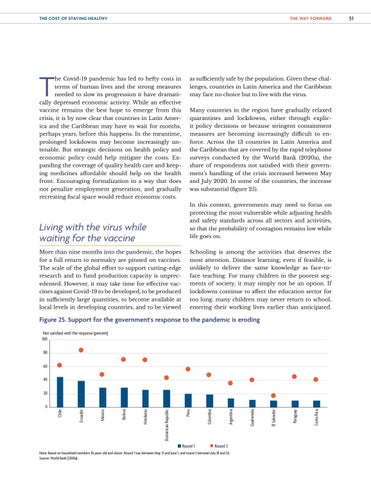The Cost of Staying Healthy
The way forward
T
he Covid-19 pandemic has led to hefty costs in
as sufficiently safe by the population. Given these chal-
terms of human lives and the strong measures
lenges, countries in Latin America and the Caribbean
needed to slow its progression it have dramati-
may face no choice but to live with the virus.
cally depressed economic activity. While an effective vaccine remains the best hope to emerge from this
Many countries in the region have gradually relaxed
crisis, it is by now clear that countries in Latin Amer-
quarantines and lockdowns, either through explic-
ica and the Caribbean may have to wait for months,
it policy decisions or because stringent containment
perhaps years, before this happens. In the meantime,
measures are becoming increasingly difficult to en-
prolonged lockdowns may become increasingly un-
force. Across the 13 countries in Latin America and
tenable. But strategic decisions on health policy and
the Caribbean that are covered by the rapid telephone
economic policy could help mitigate the costs. Ex-
surveys conducted by the World Bank (2020a), the
panding the coverage of quality health care and keep-
share of respondents not satisfied with their govern-
ing medicines affordable should help on the health
ment’s handling of the crisis increased between May
front. Encouraging formalization in a way that does
and July 2020. In some of the countries, the increase
not penalize employment generation, and gradually
was substantial (figure 25).
recreating fiscal space would reduce economic costs. In this context, governments may need to focus on protecting the most vulnerable while adjusting health and safety standards across all sectors and activities,
Living with the virus while waiting for the vaccine
so that the probability of contagion remains low while life goes on.
More than nine months into the pandemic, the hopes
Schooling is among the activities that deserves the
for a full return to normalcy are pinned on vaccines.
most attention. Distance learning, even if feasible, is
The scale of the global effort to support cutting-edge
unlikely to deliver the same knowledge as face-to-
research and to fund production capacity is unprec-
face teaching. For many children in the poorest seg-
edented. However, it may take time for effective vac-
ments of society, it may simply not be an option. If
cines against Covid-19 to be developed, to be produced
lockdowns continue to affect the education sector for
in sufficiently large quantities, to become available at
too long. many children may never return to school,
local levels in developing countries, and to be viewed
entering their working lives earlier than anticipated.
Figure 25. Support for the government's response to the pandemic is eroding Not satisfied with the response (percent) 100 80 60 40
Round 1
Round 3
Note: Based on household members 18 years old and above. Round 1 was between May 21 and June 1, and round 3 between July 18 and 26. Source: World Bank (2020a).
Costa Rica
Paraguay
El Salvador
Guatemala
Argentina
Colombia
Peru
Dominican Republic
Honduras
Bolivia
Mexico
Ecuador
0
Chile
20
51



